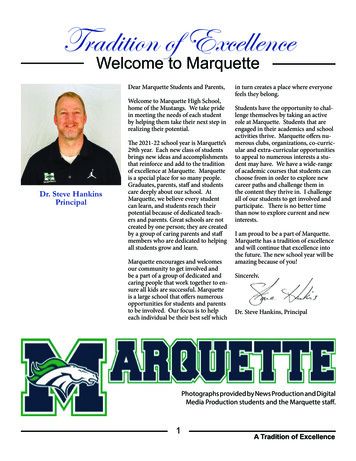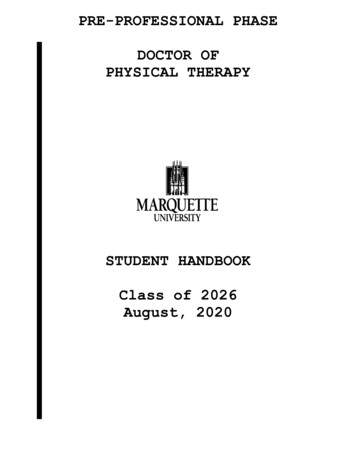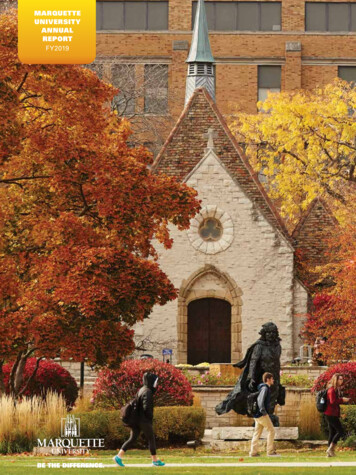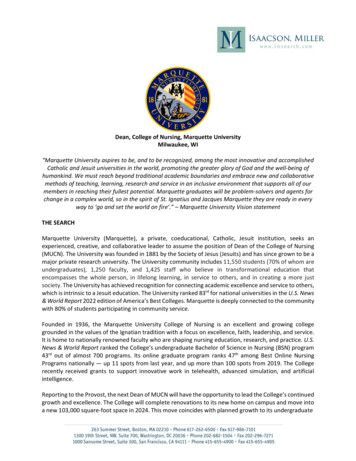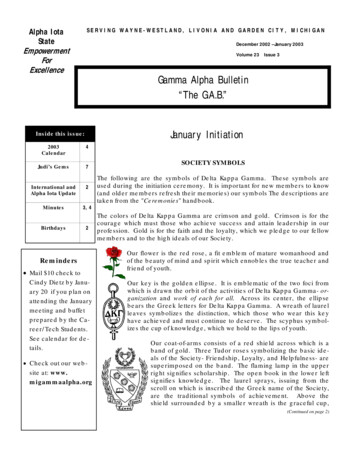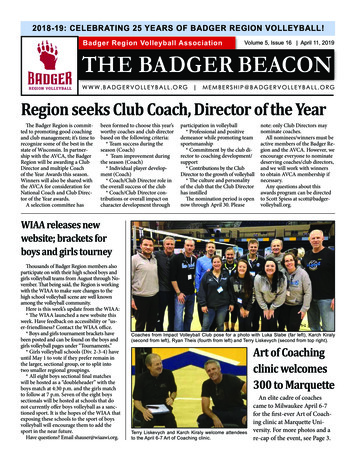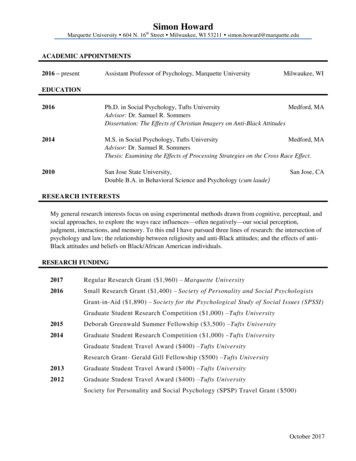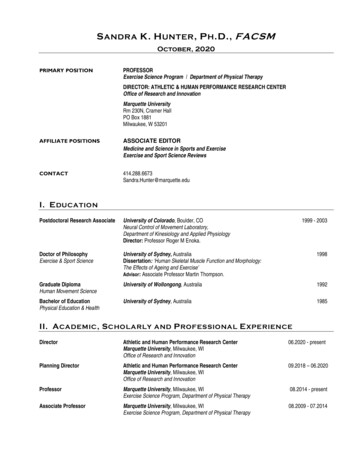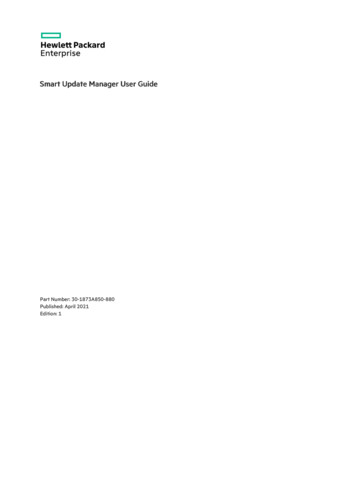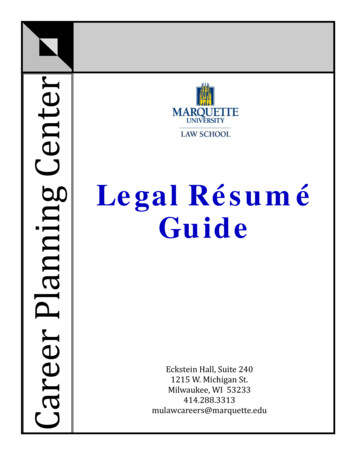
Transcription
Legal RésuméGuideEckstein Hall, Suite 2401215 W. Michigan St.Milwaukee, WI 53233414.288.3313mulawcareers@marquette.edu
CONTENTSI.INTRODUCTION . . . . . . . . . . . . . . . . . . . . . . . . . . . . . . . . . . . . . . . . . . . . . . . . . . . . . . . . . . . . . . . . . . . . . . . . 1II.FORMAT AND STYLE . . . . . . . . . . . . . . . . . . . . . . . . . . . . . . . . . . . . . . . . . . . . . . . . . . . . . . . . . . . . . . . . . . . .1A.B.C.D.E.F.G.III.Avoid Résumé Templates. . . . . . . . . . . . . . . . . . . . . . . . . . . . . . . . . . . . . . . . . . . . . . . . . . . . . . . . . . . 1Font. . . . . . . . . . . . . . . . . . . . . . . . . . . . . . . . . . . . . . . . . . . . . . . . . . . . . . . . . . . . . . . . . . . . . . . . . . . . 2Paper. . . . . . . . . . . . . . . . . . . . . . . . . . . . . . . . . . . . . . . . . . . . . . . . . . . . . . . . . . . . . . . . . . . . . . . . . . . 2Margins . . . . . . . . . . . . . . . . . . . . . . . . . . . . . . . . . . . . . . . . . . . . . . . . . . . . . . . . . . . . . . . . . . . . . . . . 2Page Length . . . . . . . . . . . . . . . . . . . . . . . . . . . . . . . . . . . . . . . . . . . . . . . . . . . . . . . . . . . . . . . . . . . . . 2Reverse Chronological Order. . . . . . . . . . . . . . . . . . . . . . . . . . . . . . . . . . . . . . . . . . . . . . . . . . . . . . . . 3Proofread . . . . . . . . . . . . . . . . . . . . . . . . . . . . . . . . . . . . . . . . . . . . . . . . . . . . . . . . . . . . . . . . . . . . . . . .3BASIC OUTLINE . . . . . . . . . . . . . . . . . . . . . . . . . . . . . . . . . . . . . . . . . . . . . . . . . . . . . . . . . . . . . . . . . . . . . . . . .3A.B.Heading . . . . . . . . . . . . . . . . . . . . . . . . . . . . . . . . . . . . . . . . . . . . . . . . . . . . . . . . . . . . . . . . . . . . . . . . .3Education . . . . . . . . . . . . . . . . . . . . . . . . . . . . . . . . . . . . . . . . . . . . . . . . . . . . . . . . . . . . . . . . . . . . . . . 31.2.3.4.5.6.7.C.D.Publications . . . . . . . . . . . . . . . . . . . . . . . . . . . . . . . . . . . . . . . . . . . . . . . . . . . . . . . . . . . . . . . . . . . . . .5Experience . . . . . . . . . . . . . . . . . . . . . . . . . . . . . . . . . . . . . . . . . . . . . . . . . . . . . . . . . . . . . . . . . . . . . . .61.2.3.E.F.IV.Headings . . . . . . . . . . . . . . . . . . . . . . . . . . . . . . . . . . . . . . . . . . . . . . . . . . . . . . . . . . . . . . . .6Describing the Position . . . . . . . . . . . . . . . . . . . . . . . . . . . . . . . . . . . . . . . . . . . . . . . . . . . . .7Presenting Employment History . . . . . . . . . . . . . . . . . . . . . . . . . . . . . . . . . . . . . . . . . . . . . .9Interests, Hobbies, Special Skills, Language Proficiency, Community Activities,Other Activities. . . . . . . . . . . . . . . . . . . . . . . . . . . . . . . . . . . . . . . . . . . . . . . . . . . . . . . . . . . . . . . . . . .9Professional Associations . . . . . . . . . . . . . . . . . . . . . . . . . . . . . . . . . . . . . . . . . . . . . . . . . . . . . . . . . . 10ITEMS YOU SHOULD NOT INCLUDE . . . . . . . . . . . . . . . . . . . . . . . . . . . . . . . . . . . . . . . . . . . . . . . . . . . . . .10A.B.C.D.V.Guidelines for Law School Class Rank and GPA. . . . . . . . . . . . . . . . . . . . . . . . . . . . . . . . .4Rounding Up GPA and Class Rank. . . . . . . . . . . . . . . . . . . . . . . . . . . . . . . . . . . . . . . . . . . .4False or Misleading Information . . . . . . . . . . . . . . . . . . . . . . . . . . . . . . . . . . . . . . . . . . . . . .4Part-time/Full-time Program . . . . . . . . . . . . . . . . . . . . . . . . . . . . . . . . . . . . . . . . . . . . . . . . .4Grade Improvement. . . . . . . . . . . . . . . . . . . . . . . . . . . . . . . . . . . . . . . . . . . . . . . . . . . . . . . .4Awards, Honors and Activities . . . . . . . . . . . . . . . . . . . . . . . . . . . . . . . . . . . . . . . . . . . . . . .4High School. . . . . . . . . . . . . . . . . . . . . . . . . . . . . . . . . . . . . . . . . . . . . . . . . . . . . . . . . . . . . .5Career Objective . . . . . . . . . . . . . . . . . . . . . . . . . . . . . . . . . . . . . . . . . . . . . . . . . . . . . . . . . . . . . . . . .10Summary of Qualities . . . . . . . . . . . . . . . . . . . . . . . . . . . . . . . . . . . . . . . . . . . . . . . . . . . . . . . . . . . . .10References. . . . . . . . . . . . . . . . . . . . . . . . . . . . . . . . . . . . . . . . . . . . . . . . . . . . . . . . . . . . . . . . . . . . . . 10Skills . . . . . . . . . . . . . . . . . . . . . . . . . . . . . . . . . . . . . . . . . . . . . . . . . . . . . . . . . . . . . . . . . . . . . . . . . . 10MISCELLANEOUS. . . . . . . . . . . . . . . . . . . . . . . . . . . . . . . . . . . . . . . . . . . . . . . . . . . . . . . . . . . . . . . . . . . . . . .11A.B.C.APPENDIX:Confidentiality . . . . . . . . . . . . . . . . . . . . . . . . . . . . . . . . . . . . . . . . . . . . . . . . . . . . . . . . . . . . . . . . . . .11Try to Avoid Gaps in Your Chronology. . . . . . . . . . . . . . . . . . . . . . . . . . . . . . . . . . . . . . . . . . . . . . . .11Post-Law School Résumé: Experience First . . . . . . . . . . . . . . . . . . . . . . . . . . . . . . . . . . . . . . . . . . . .11Sample Résumés. . . . . . . . . . . . . . . . . . . . . . . . . . . . . . . . . . . . . . . . . . . . . . . . . . . . . . . . . . . . . . . . . .12
I. INTRODUCTIONYour résumé is an important part of your job search. It should be a brief, focused, dynamicmarketing tool that conveys your key credentials for a future position. A résumé generally has twofunctions: to interest a prospective employer sufficiently enough to invite you to an interview andto serve as the catalyst for interview discussion. The importance of the résumé should be reflectedin the amount of thought, time, and effort youput into its preparation.A poorly prepared résumé providesan easy reason for the employer toYour résumé represents you; it speakseliminate a candidate.to the reader in terms of its content and itsappearance. Judgments will be made aboutyou as a candidate based upon the physical appearance of your résumé. Many employers willsummarily discard résumés that are presented on poor quality paper when hard copy is required orotherwise contain typos, spelling errors, formatting issues and/or are saved in an electronic filesource that isn’t accessible or alters formatting. The concern is that if you do not care enough toinvest the time and effort necessary to prepare an attractive and accurate résumé of your owncredentials, what kind of effort will you be willing to put in on behalf of the employer and/or itsclients to produce a first-class work product? Many legal employers receive several hundredrésumés for a single position. A poorly prepared résumé provides an easy reason for the employerto eliminate a candidate. Appearance and content matter.II. FORMAT AND STYLELegal résumés have industry standards for format and style. Within the standards there areoptions for presentation of information. Know the accepted options and be deliberate in yourchoices regarding format. You may choose any one of the many résumé formats so long as theformat emphasizes your strengths, does not provide inappropriate or unnecessary information, andcan be quickly scanned by the reader. A prospective employer may not give more than 30 secondsto reviewing your résumé, so it should be designed to focus the reader’s attention on relevantinformation.You are marketing yourself as a professional, so your résumé should appear professional.Most often you will provide your résumé electronically as an attached document or through anonline application system. Save your résumé as a PDF and confirm retention of formatting prior tosubmitting a document electronically. If you are submitting a hard copy of your résumé, it shouldbe word processed and printed using a quality printer. Although this is not an iron-clad rule, try toavoid abbreviations. Permissible abbreviations include state names and college degrees. Anexample where you should avoid abbreviation is the word “memos,” as it should be written out asmemorandums or memoranda.A.Avoid Résumé Templates.Templates and their forced construction undermine one of the basic rules of résuméconstruction: Your experiences, your information, and the specific audience of your résumé shoulddictate the form and structure of the document. Templates function in the converse. The template
imposes a structure that frequently dictates where you can locate information and how muchinformation you can place on the document. Moreover, most templates are geared towards abusiness résumé, not a legal résumé, and to individuals with extensive work history, not a lawstudent seeking his/her/their first legal position.B.Font.Generally, you should use between 10- and 12-point font size for the body of thedocument. Font size up to 14-point can be used in the heading. Never use a font size less than 10point. Regarding font type, it is best to stick with common, traditional fonts such Times NewRoman, Courier, Arial and Cambria. Avoid using multiple fonts.C.Paper.When you present a hard copy of your résumé, use high-grade quality white, off-white, ora pale grade shade of 25% or greater cotton bond 8½-inch x 11-inch paper.D.Margins.Use standard ¾-inch or 1-inch margins. Although the top margin can be a bit smaller (e.g.,7/10-inch), the right and left margins should be no less than ¾ inches. The bottom margin can beas small as ½ inch. There should be a balance of white space on the page.E.Page Length.A one-page résumé is highly preferred, especially for first-year students with no legalexperience. Individuals with substantial professional experience and/or graduate degrees mightwarrant a two-page résumé. In an effort to limit your résumé to one page, do not (i) reduce the fontsize to below 10-point to squeeze the information on one page, (ii)reduce the margins and/or line spacing thereby covering the pageA one-page résuméwith information and leaving minimal white space, or (iii)is highly preferred.eliminate information that an employer might consider relevant.Try to get all your information on a single page, but rather thanbeing overly concerned with the length of your résumé, it is better to focus on delivering what isreally important to the employer, e.g., your academic success and extracurricular activities atMULS and any legal or legal-related experience. Often undergraduate and non-legal experiencescan be eliminated or greatly reduced as they do not advance the professional brand you arepromoting with your résumé.If your résumé does warrant two pages, avoid the trap of providing so much informationthat the employer can make a decision on your candidacy without an interview. Also, if you havea two-page résumé, include a header on the second page that serves to identify it as the secondpage of your résumé (see, e.g., Sample Résumé #7 in the Appendix).Legal Résumé Guide, p. 2
F.Reverse Chronological Order.All entries on your résumé should be listedin reverse chronological order within eachsection, beginning with the most recent andworking backwards.G.All entries on your résumé shouldbe listed in reverse chronologicalorder within each section.Proofread.Proofread your final copy very carefully to be certain there are no spelling, grammatical ortypographical errors. Proper nouns, e.g., names of schools and employers, are most commonlymisspelled. Note that the default setting in a Microsoft Word document is to not spellcheck wordsthat are typed in uppercase, which means that it is easy for a misspelled word in a heading to goundetected. To change the default setting in Word, select “File” then select “Options” at the bottomof the menu. From the menu select “Proofing” and deselect “Ignore words in UPPERCASE.”III.BASIC OUTLINEItems on your résumé should be presented in order of importance and relevance to thereader. In the initial scan of your résumé, the reader will be looking for something about you toinduce a closer examination of your credentials. If that something does not grab the reader’sattention right away, your chances for further consideration are greatly reduced. The followingguidelines primarily are geared toward law students and recent graduates who are seeking legal orlegal-related positions.A.Heading.The heading of your résumé should include your name, street address, email address, andtelephone number(s) where you can be reached. If you include both your home and cell/mobilephone numbers, identify them with “(H),” or “(Home),” and “(C)” or “(M)” or “(Cell)” or“(Mobile).” List both your school address and a permanent address only if you are seeking a job inthe geographic area in which the permanent address is located and there is nothing else on yourrésumé connecting you to that area. It is appropriate to include your LinkedIn URL in your heading,but only do so if you are committed to updating and maintaining your profile.B.Education.Information about your law school, undergraduate work, graduate studies, and relatedactivities, awards, achievements, and accomplishments should be presented under the heading“Education.” List the schools you attended in reverse chronological order with MarquetteUniversity Law School first. For law school, list the degree that you are pursuing (Juris Doctor)and your anticipated date of graduation, not dates attended. Include the month and year yourundergraduate and any other graduate degrees were conferred and the specific degree(s) received.Legal Résumé Guide, p. 3
Below are general guidelines to follow. Academic performance in undergraduate or other graduateeducation should follow the same guidelines as for law school.1.Guidelines for Law School Class Rank and GPA. Include class rank if you arein the upper half of your class (i.e., top 50%); otherwise, leave it off. Note thatMarquette does not rank students until June following their first year. Generally, youshould include your GPA if it places you in the upper half of your class and/or it isa 3.0 or above.2.Rounding Up GPA or Class Rank. Do not round up (or down) your GPA or yourclass rank. Your stated GPA and class rank must be absolutely accurate. A 2.978GPA is not 3.0 or even 2.98. If you arejust below the 25th percentile in yourDo not round up (or down)class, do not state that you are in theyour GPA or your class rank.“top quarter.” Do not place a rank“guesstimate” on your résumé, e.g., ifYour stated GPA and class rankyou just missed the cutoff for top 10%must be absolutely accurate.you must state your rank as “Top 15%,”not “Top 11%.”3.False or Misleading Information. Do not include false or misleading information.If the Law School learns of anyone deliberately giving false information about lawschool credentials, the person will be referred to the Investigative Committee forpossible disciplinary action (see Section 901(2) of the Marquette University LawSchool Academic Regulations). In addition, if a prospective employer learns thatyou have lied or included misleading information on your résumé, you have acredibility and character issue that will be difficult to explain away -- assuming theemployer even provides you an opportunity for explanation. Further, intentionalmisrepresentations on any application may impact your admission to practice law.4.Part-time/Full-time Status. Do not include whether you are enrolled part-time orfull-time. It is unnecessary to distinguish as the courses, grading, and expectationsare the same.5.Grade Improvement. If you have a strong upward trend in your grades, considerseparating your GPA by semester or year in law school to highlight yourimprovement. If you use this approach, make sure you put your best result first bylisting the semesters or years in reverse chronological order with the best gradesflush left. People tend to read from left to right and you want them to see first yourmost impressive grades. For example:Second Semester GPA: 3.544/4.0006.First Semester GPA: 2.458 Overall GPA: 3.001Awards, Honors and Activities. Include any academic honors (e.g., cum laude,magna cum laude, summa cum laude, Phi Beta Kappa, Dean’s List, awards foracademic achievement, moot court successes, merit-based scholarships), law schoolLegal Résumé Guide, p. 4
extra-curricular activities and publications (e.g., Marquette Law Review and MootCourt Board), and other scholarly law journal participation. Offer just enoughdescription of any award, honor, or activity so that the reader will understand it.7. Scholarships. Include any scholarships you received and, space permitting,describe the value of the scholarship. For example: “Jonathan WilhausenScholarship (full-tuition, merit-based scholarship – one of 3 distributed toincoming class).” CALI Award. If you receive an Excellence for the Future Award from theCenter for Computer-Assisted Legal Instruction – commonly referred to as aCALI Award -- in recognition of receiving the highest grade in a law schoolcourse, include the course and semester, e.g., “CALI Award (highest grade),Remedies (Spring 2020).” Student Organizations. When listing student organizations, always list the fullname of the organization, not initials, and any office(s) held. Such items shouldbe listed rather than presented in paragraph form. Athletic Achievements. Significant athletic achievements may also be included.Athletic achievements can speak well of you since they reflect on yourcompetitiveness, dedication, self-motivation and self-discipline, and ability toperform under pressure. Other Activities. Include other law school or related activities that clearlydemonstrate positive qualities impressive to any résumé reader, such asvolunteer activities and clinical placements. Purely social activities are best leftoff your résumé unless you held a leadership position, or the activity is unusual,and you are prepared to discuss it in an interview in a manner that enhancesyour candidacy.High School. Do not include your high school unless you attended a prestigiousprivate school with which you are confident an employer would be familiar and thatmay indicate to the employer that you have client development potential.Always remember to list the assets that are your greatest selling points, but do not overload.This is true for undergraduate and other advanced degrees. Excellence in academics and activitiesbefore law school is worth noting but be selective. You do not want to overshadow your law schoolrelated experiences.C.Publications.If you have written a law-related article while in law school that has been accepted forpublication, present it immediately after the education section of your résumé under a separate“Publications” heading. Cite legal publications in accordance with The Bluebook or other acceptedLegal Résumé Guide, p. 5
citation system in the legal community where the receiving employer is located. If the article isnot law-related or was published pre- or post-law school, list it under a separate section titled“Publications” towards the end of your résumé.D.Experience.Describe and showcase your qualifications, skills, and achievements instead of your dutiesand responsibilities. Make the information interesting to the reader and easy to digest by describingyour experience in short statements. Use present tense verbs to describe your skills andaccomplishments in a current position and past tense for all former positions. All entries shouldbe in reverse chronological order under their respective headings.Headings. There are several options for experience headings. A few examples areprovided below with several more examples provided on the sample résumés foundat the end of this guide. The catch-all category “Experience” also is appropriate. Theselection of headings should be dictated by your experiences and the receivingemployer’s focus, so avoid templates.1.aLegal Experience. If you have or have had practical legal experience, the headingshould read “Legal Experience,” “Legal-related Experience,” or simply“Experience.” Legal experience is the most important experience on a résumé forstudents who are pursuing traditional legal careers, so it should be listed first. Legalexperience includes paid legal jobs, work performed for professors, legalinternships, and volunteer legal work. Sports-industry résumés may list sportsspecific experience first.bProfessional Experience. This category can be used if you have had a previous orpresent career. If you also have a “Legal Experience” section, “Other ProfessionalExperience” or “Additional Professional Experience” is appropriate. Listing thesetypes of jobs separately allows the employer to note at a glance the most relevantexperience.cAdditional Experience or Non-Legal Experience. This category includesemployment that is not at a professional level. The heading “Non-Legal Experience”is appropriate only if you have a “Legal Experience” category. Part-time andsummer jobs such as server, store clerk, camp counselor, etc., can be included in thiscategory. Students who have no professional experience will want to include thesetypes of experiences since they might highlight various transferable skills. Unlikethe experiences under “Legal Experience” and “Professional Experience,” jobsunder this section can be listed without descriptions. A simple sentence such as,“Various summer and part-time positions to finance education, including.” also cansuffice. Some employers will recognize the dedication and ambition that workingone’s way through school requires and realize that such an accomplishment can bean extenuating circumstance for not being at the top of the class. Use your judgmentas to whether these entries add to your résumé.Legal Résumé Guide, p. 6
2.Describing the Position. Identify the name of the employer and the city and statein which it is located, state your job title (e.g., Intern, Judicial Extern, Pastry Chef,Law Clerk) and the dates that you were employed (month and year or season, e.g.,“May 2020-August 2020” or “Summer 2020”), then describe your experience. Donot isolate and highlight the dates by aligning them in the left margin. Doing sohighlights length of employment, which is a weakness for most law students as manywork histories include job-hopping through non-legal, non-related positions.a. Be brief. Be concise. The description of your experience should be brief enough soas not to lose the reader’s attention and yet complete enough to give the reader aclear idea of the skills you acquired/utilized and the accomplishments you achieved.Use short descriptive phrases that denote successes and relevant skills. You are notdrafting a job description, rather, you are drafting statements to market yourcandidacy. Use the space on your résumé to detail legal and relevant experiencesrather than non-legal and/or non-professional.b. Avoid personal pronouns. Do not use personal pronouns such as I, me, my, us, we,anywhere on your résumé.c. Start sentences with action verbs. Begin each sentence with an action verb or adescriptive word. Tasks may or maynot translate from career to career, butskills are transferable. Do not begin aDo not begin a sentence ties include” orinclude” or “Duties include.” They are“Duties include.”weak phrases that take up space andprohibit the reader from focusing onimportant or relevant information. Alist of action verbs is provided on the following page. Note that verbs “assist” and“help” are not strong options as they are vague and fail to denote a specific skill.Legal Résumé Guide, p. 7
wWonWorkedWroted. Accentuate your accomplishments. Focus on job accomplishments as much aspossible. Prospective employers are very interested to learn what you specificallyaccomplished with respect to the activities you performed, particularly if suchaccomplishments are relevant to the position for which you are applying. Jobaccomplishments include your successes, the expertise you acquired, and, withrespect to legal experience, specific laws, and areas of law with which you havebecome familiar.If you are a first-year law student, do not be too concerned if your accomplishmentsseem rather limited. If you have no specifics, try quantifying aspects of yourexperience, e.g., the number of individuals you supervised, the number of reportsyou drafted, the amount you reduced overtime and increased productivity. SpecificLegal Résumé Guide, p. 8
numbers and percentages add definition and describe the scope of activities betterthan words. They are also objective, allowing the résumé reviewer to draw clearconclusions about your accomplishments and qualifications without having toconfront gratuitous, subjective assertions.e. Revisit and revise. Revisit and revise existing descriptions as your résumé develops.Contingent on your target employers, you may benefit from emphasizing or deemphasizing aspects of a job to best fit the target employer’s preferred experienceand stated qualifications.3.E.Presenting Employment History. There is no absolute rule about how many yearsyou should date back your work experience. However, if you have substantialexperience, i.e., more than 10 years, you might consider deleting from your résuméwork experience that dates back more than 10 or 15 years. If you entered law schooldirectly from undergrad, do not include employment from high school or earlierunless it is outrageously impressive, and/or you know with certainty the informationwill resonate positively with the specific recipient.Interests, Hobbies, Special Skills, Language Proficiency, CommunityActivities, Other Activities.If you have a foreign language proficiency (e.g., fluent, conversational), unusual orinteresting hobbies, athletic activities, and/or community organizations in which you activelyparticipate, include them on your résumé if you have space. Information of this sort gives the readerinsight into your personality and can be excellent interview fodder for employers seeking to exploreissues of “fit.”The general rule for hobbies/interests is to include those hobbies or interests that areunique, that you can discuss in a manner that makesyou an interesting person and/or storyteller, thatInclude those hobbies ordenote discipline or intellect, that highlightinterests that are unique, showleadership, that support client development skills,discipline, client developmentand/or that otherwise connect with the employer.Only include those that you are prepared to have askills, leadership ability, or makeconversation about during interviews and thea connection with the employer.discussion of which makes you seem engaging andinteresting to the interviewer. Avoid interests andactivities that might be controversial or otherwise highly charged.Community involvement almost universally is viewed positively by employers. This isparticularly important for law students and recent graduates who may have little professional workexperience. Furthermore, some law firms feel that outside activities are a good source for potentialbusiness and/or a sign of a candidate’s willingness to actively represent the firm to the localcommunity.Legal Résumé Guide, p. 9
F.Professional Associations.Membership in professional organizations should be listed in a separate category. Alwayspresent legal organizations first.IV. ITEMS YOU SHOULD NOT INCLUDEA.Career Objective.Some résumé guides suggest that you place a “Career Objective” or similar section at thehead of your résumé. Such a section might be appropriate for other professions, but it is notappropriate for a law student seeking a position in the legal profession. Stating a career objectiveat the outset certainly helps to focus the reader quickly on the type of employment you are seeking.The problem is that a job objective can be very limiting, especially if you are specific. Youpotentially rule yourself out of consideration for other positions that do not match exactly whatyou describe. Moreover, there is a danger that you turn the reader off by starting out with what youare interested in rather than orienting your résumé to what the employer needs and desires. If yourrésumé presents your education and work experience cohesively, the positions for which you arequalified should be quite evident to the reader, and a career objective is unnecessary. The best wayto let an employer know your specific interest is through a cover letter and/or in an interview.B.Summary of Qualities.“Summary of Qualities” is another section that some traditional résumé guides tell you toinclude with content such as, “Great sense of humor, work well with others, spirited.” Thisinformation is not appropriate for legal résumés.C.References.Do not place “ReferencesDo not place “References available uponavailable upon request” on arequest” on a legal résumé. It is unnecessary and willbe assumed by most employers regardless. In thelegal résumé.inter
Information about your law school, undergraduate work, graduate studies, and related activities, awards, achievements, and accomplishments should be presented under the heading "Education." List the schools you attended in reverse chronological order with Marquette University Law School first. For law school, list the degree that you are .

